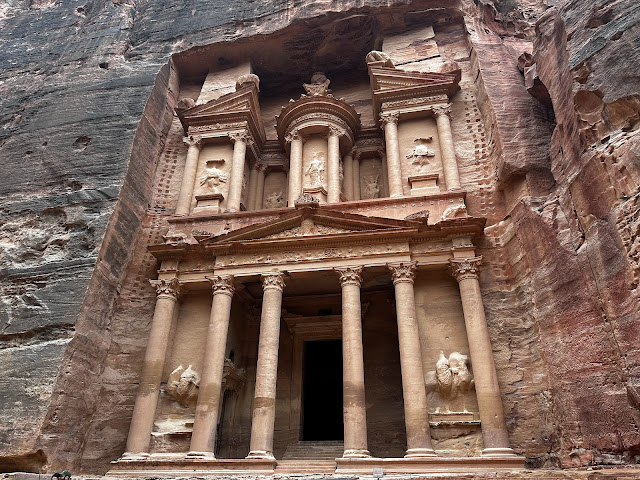The Giza pyramid complex consists of the Great Pyramid of Khufu, the Pyramid of Khafre, and the Pyramid of Menkaure, their associated pyramid complexes and the Great Sphinx. All the structures within the complex are widely believed to have been constructed between 2600 BCE to 2500 BCE, during the Fourth Dynasty of the Old Kingdom of ancient Egypt. The complex was inscribed as a UNESCO World Heritage Site in 1979 CE.
 |
| A distant view of the Giza Pyramid Complex |
The Great Pyramid of Khufu was constructed around 2600 BCE. The pyramid was initially believed to have stood at 481 feet. It was the tallest structure constructed on the planet for over 3800 years until the construction of the Lincoln Cathedral of England in 1311 CE (which was documented to be 525 feet in height). The complex consists of a valley temple, the Mortuary Temple of Khufu, as well as three smaller queen's pyramids. The Great Pyramid was one of the earliest mentioned “Seven Wonders of the Ancient World” listed by the ancient Greek poet Antipater of Sidon. It was the oldest of the listed monuments and the only one which still stands (the others were the Colossus of Rhodes, the Lighthouse of Alexandria, the Mausoleum at Halicarnassus, the Temple of Artemis, the Statue of Zeus at Olympia, and the Hanging Gardens of Babylon).
 |
| The Great Pyramid of Giza |
 |
| A closer look at the Great Pyramid of Giza |
%20-%20(3).jpg) |
| The Statue of Khufu (reigned from 2589 BCE to 2566 BCE) in display at the Cairo Museum of Egyptian Antiquities (Height: 7.5 cm; width: 2.5 cm; depth: 2.9 cm) |
 |
| The three smaller queen's pyramids associated with the Great Pyramid of Giza |
Khafre's pyramid complex consists of a valley temple, the Sphinx temple, a causeway, a mortuary temple, and the king's pyramid. Pharaoh Khafre was the son of Pharoah Khufu, the builder of the Great Pyramid. The king’s pyramid was constructed around 2570 BCE, and it rises up to 448 feet in height. Mainstream historians and Egyptologists date the Great Sphinx to the reign of Pharaoh Khafre, widely believing that he is the face depicted on the Great Sphinx (https://ancientjourneys.blogspot.com/2023/01/the-great-sphinx-of-giza.html). |
| The Pyramid of Khafre |
.jpg) |
The statue of Khafre (reigned from 2558 BCE to 2532 BCE) in display at the Cairo Museum of Egyptian Antiquities. The statue was discovered in a pit under his valley temple at Giza
|
 |
| The Great Sphinx with the Pyramid of Khafre in the background |
 |
The Great Sphinx with the Great Pyramid in the background. It is widely believed that the face depicted on the Great Sphinx belongs to Pharaoh Khafre
|
Menkaure's pyramid complex consists of a valley temple, a causeway, a mortuary temple, and the king's pyramid, and three queen’s pyramids. Pharaoh Menkaure was the son of Khafre and the grandson of Khufu. He reigned for a period of 18 to 22 years starting from 2530 BCE. The king's pyramid which was completed around 2510 BCE, has three subsidiary or queen's pyramids. Smaller in size in comparison to the pyramids of his father and grandfather, the king’s pyramid originally stood at only 215 feet.
 |
| The Pyramid of Menkaure |
.jpg) |
| Triad of Menkaure in display at the Cairo Museum of Egyptian Antiquities: These statues were found in the valley temple of Menkaure. Menkaure is depicted in the middle with the Goddess Hathor standing to his right and the Bat-nome goddess standing to his left |
.jpg) |
| Triad of Menkaure in display at the Cairo Museum of Egyptian Antiquities: These statues were found in the valley temple of Menkaure. Menkaure is depicted in the middle with the Goddess Hathor standing to his right and the Jackal-nome goddess standing to his left |
.jpg) |
| Triad of Menkaure in display at the Cairo Museum of Egyptian Antiquities: These statues were found in the valley temple of Menkaure. Menkaure is depicted in the middle with the Goddess Hathor standing to his right and the Theban-nome god standing to his left |
The pyramids of Giza and others are thought to have been constructed to house the remains of the deceased pharaohs who ruled Ancient Egypt. The “Orion Correlation Theory” put forward by Robert Bauval, which later expanded to the existence of an ancient lost civilization (which was destroyed in a cataclysm at the end of the last ice age), argued that the relative positions of the three main pyramids were designed to correlate with the relative positions of the three stars in the constellation of Orion which make up Orion's Belt, as these stars appeared in 10,500 BCE (which coincides with the end of the last ice age). While the theory is highly disputed, it argues that the survivors of this lost civilization passed their knowledge to the hunter-gatherer communities, giving rise to the earliest known civilizations of ancient Egypt, Mesopotamia (modern day Iraq), and Mesoamerica.



%20-%20(3).jpg)


.jpg)



.jpg)
.jpg)
.jpg)



Comments
Post a Comment